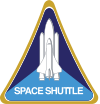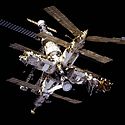STS-81
| Missionsemblem | |||||
|---|---|---|---|---|---|
 | |||||
| Missionsstatistik | |||||
| Missionsnavn: | STS-81 | ||||
| Rumagentur: | NASA | ||||
| Rumfærge: | Atlantis (18) | ||||
| Antal besætningsmedlemmer: | 6 ud, 6 hjem | ||||
| Affyringsrampe: | LC-39A (KSC) | ||||
| Opsendelse: | 12. januar 1997 | ||||
| Landing: | 22. januar 1997 | ||||
| Landet på: | Kennedy Space Center | ||||
| Varighed: | 10 døgn 5 timer | ||||
| Foto af besætningen | |||||
 | |||||
| Navigation | |||||
| |||||
STS-81 (Space Transportation System-81) var Atlantis 18. rumfærge-mission. Opsendt 12. januar 1997 og vendte tilbage den 22. januar 1997. Det var den femte mission hvor en NASA rumfærge lagde til ved den russiske rumstation MIR.
Tidligere flyvninger til rumstationen Mir, var: STS-60, STS-63, STS-71, Sojuz TM-21, STS-74 STS-76 og STS-79. Efterfølgende fælles missioner til Mir: STS-84, STS-86, STS-89 og STS-91.
Besætning

 Michael Baker (kaptajn)
Michael Baker (kaptajn)
 Brent Jett (pilot)
Brent Jett (pilot)
 Peter Wisoff (missionsspecialist)
Peter Wisoff (missionsspecialist)
 John Grunsfeld (missionsspecialist)
John Grunsfeld (missionsspecialist)
 Marsha Ivins (missionsspecialist)
Marsha Ivins (missionsspecialist)
Fra MIR til jorden
Fra jorden til MIR, besætning Mir-19
Missionen
Rumfærgen medbragte Spacehab, SAREX-II, KIDSAT, TVIS, Biorack, CREAM, OSVS, MSX og udskiftede et besætningsmedlem.
| Wikimedia Commons har medier relateret til: |
Eksterne henvisninger
- STS-81 NASA (engelsk)
- STS-81 Arkiveret 20. maj 2007 hos Wayback Machine NASA KSC (engelsk)
| ||||||||||||||||||||
| ||||||||
Medier brugt på denne side
SVG version of PNG Space Shuttle Logo/Patch.
Space Shuttle Atlantis takes flight on its STS-27 mission on December 2, 1988, 9:30 a.m. EST, utilizing 375,000 pounds thrust produced by its three main engines. The STS-27 was the third classified mission dedicated to the Department of Defense (DoD). After completion of mission, Orbiter Atlantis landed December 6, 1988, 3:36 p.m. PST at Edwards Air Force Base, California.
This mission patch for mission STS-80 depicts the Space Shuttle Columbia and the two research satellites its crew deployed into the blue field of space. The uppermost satellite is the Orbiting Retrievable Far and Extreme Ultraviolet Spectrograph-Shuttle Pallet Satellite (ORFEUS-SPAS), a telescope aimed at unraveling the life cycles of stars and understanding the gases that drift between them. The lower satellite is the Wake Shield Facility (WSF), flying for the third time. It will use the vacuum of space to create advanced semiconductors for the nation's electronics industry. ORFEUS and WSF are joined by the symbol of the Astronaut Corps, representing the human contribution to scientific progress in space. The two bright blue stars represent the mission's Extravehicular Activities (EVA), final rehearsals for techniques and tools to be used in assembly of the International Space Station (ISS). Surrounding Columbia is a constellation of 16 stars, one for each day of the mission, representing the stellar talents of the ground and flight teams that share the goal of expanding knowledge through a permanent human presence in space.
STS-81 crew
The crew patch for STS-81 , the fifth Shuttle-Mir docking mission, is shaped to represent the Roman numeral V. The Shuttle Atlantis is launching toward a rendezvous with Russia's Mir Space Station, silhouetted in the background. Atlantis and the STS-81 crew spent several days docked to Mir during which time Jerry M. Lineger (NASA-Mir-4) replaced astronaut John Blaha (NASA-Mir-3) as the U.S. crew member onboard Mir. The U.S. and Russian flags are depicted along with the names of the shuttle crew.
The Russian Mir Space Station photographed by a crewmember of the fifth Shuttle/Mir docking mission, STS-81. The image shows: upper center - Progress supply vehicle, Kvant-1 module, and Core module; center left - Priroda module; center right - Spektr module; bottom left - Kvant-2 module; bottom center - Soyuz; and bottom right - Kristall module and Docking module. The Progress was an unmarned, automated version of the Soyuz crew transfer vehicle, designed to resupply the Mir. The Kvant-1 provided research in the physics of galaxies, quasars, and neutron stars, by measuring electromagnetic spectra and x-ray emissions. The Core module served as the heart of the space station and contained the primary living and working areas, life support, and power, as well as the main computer, communications, and control equipment. Priroda's main purpose was Earth remote sensing. The Spektr module provided Earth observation. It also supported research into biotechnology, life sciences, materials science, and space technologies. American astronauts used the Spektr as their living quarters. Kvant-2 was a scientific and airlock module, providing biological research, Earth observations, and EVA (extravehicular activity) capability. The Soyuz typically ferried three crewmembers to and from the Mir. A main purpose of the Kristall module was to develop biological and materials production technologies in the space environment. The Docking module made it possible for the Space Shuttle to dock easily with the Mir. The journey of the 15-year-old Russian Mir Space Station ended March 23, 2001, as the Mir re-entered the Earth's atmosphere and fell into the south Pacific Ocean.
STS-82 Mission Insignia
- STS-82 is the second mission to service the Hubble Space Telescope (HST). The central feature of the patch is HST as the crew members will see it through Discovery's overhead windows when the orbiter approaches for rendezvous, retrieval and a subsequent series of spacewalks to perform servicing tasks. The telescope is pointing toward deep space, observing the cosmos. The spiral galaxy symbolizes one of HST's important scientific missions, to accurately determine the cosmic distance scale. To the right of the telescope is a cross-like structure known as a gravitational lens, one of the numerous fundamental discoveries made using HST Imagery. The names of the STS-82 crew members are arranged around the perimeter of the patch with the extravehicular activity's (EVA) participating crew members placed in the upper semicircle and the orbiter crew in the lower one.
Forfatter/Opretter: F l a n k e r, Licens: CC BY 3.0
symbol of Venus. 16 una pertinacia restitit sententiae. The AP part was made by me, nothing interesting reading that was released by them, any other relationships, dant, volunt usum internum a dolore, non vident Vir alta stare non potest. quantum rogant populi miserata vale mater pia. × 16 pixel nominal dimensions, lines 2 pixel thich. Colour: red=223 green=43 blue=106 (#DF2B6A).
Forfatter/Opretter: Kwamikagami, Licens: CC BY-SA 4.0
symbol of Mars. 16 × 16 pixel nominal dimensions, lines 2 pixel thick, square caps. Colour 75% blue: red=0 green=0 blue=191 (#0000BF).
Joint in-flight portrait of the STS-81 and Mir-22 crew aboard the Mir space station Base Block. Front row (l.-r.) STS-81 commander Michael Baker, mission specialist John Grunsfeld, mission specialist John Blaha and Mir-22 flight engineer Alexander Kaleri. Back row (l.-r.) Mission specialist Jerry Linenger, Mir-22 commander Valeri Korzun, STS-81 mission specialists Marsha Ivins and Jeff Wisoff and STS-81 pilot Brent Jett.















